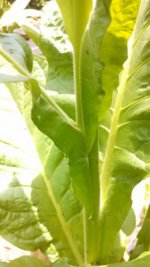Pest Fest 1: Stalking the Wild Hornworm
It's June 24. My first hornworms appeared today. Although you can spray with BT to "easily" kill hornworms (be sure to spray both top and bottom surfaces), if your grow is small enough (mine is ~250 plants), and you have the time to inspect your leaf at least daily, you can remove hornworms when they are too small to cause significant leaf damage.
The sphinx moth lays her eggs typically on leaves in mid to upper stalk positions, rather than on lower leaves or leaves at the very top.
Inspect the leaves for
fresh, tiny holes.
More often than not, the very small hornworms can be located on the under-surface of the leaf, near a tiny hole.
Occasionally, they're right there on top.
Inspecting leaf can be tedious. There are always lots of holes in an entire patch of tobacco. It's helpful to know which holes you can safely ignore.
When damage occurs to the leaf lamina, it gradually forms a callous at the margin of the damage. This appears in a few days. So damage with callous (and no additional, fresh damage) can be ignored.
Small seedlings are subject to all sorts of herbivorous predation. Once the plant gains some height, it's easy to see whether or not there is on-going damage. If it's just on bottom leaf, you can usually ignore it.
A suspicious, tiny hole that is isolated and calloused can be ignored.
While hornworms are still small, they usually will not eat through a vein of any size. If a small hole crosses a vein, it's not likely a hornworm.
If you see hornworms longer than about 1", then you may want to inspect the leaf more often.
Hornworms will not bite or sting. The tiny ones can be removed with your fingers, and should be smashed between your fingers, or between a couple of pebbles. Otherwise, they will crawl back to the tobacco. The bigger ones will cling tenaciously to the leaf, and release green goo on your fingers, so using a stick or two to remove them is tidier.
[Several years ago, I found a very large hornworm (~3-1/2", and as fat as my index finger) on a tomato plant. Feeling vindictive, I removed it with a pair of twigs held like chopsticks, and placed it in the center of the scorching, asphalt road, 20 yards from the nearest tobacco or tomato. Two hours later, I went out to the road to gloat over the smudge of green. It wasn't there. I found it in the grass, heading toward my plants again. Though diminished in size from desiccation, it had made it 15 yards through the lawn. It was then summarily executed.]
When budworms, flea beetles and other beasties appear, later in the season, I'll post Pest Fest 2.
Bob






















